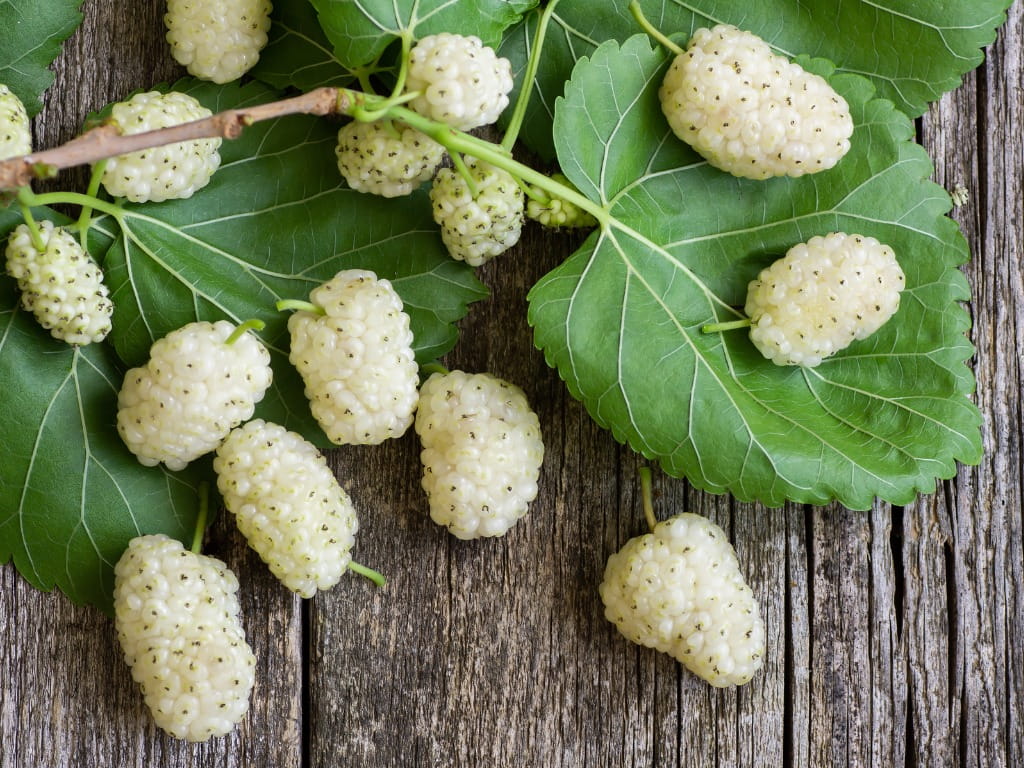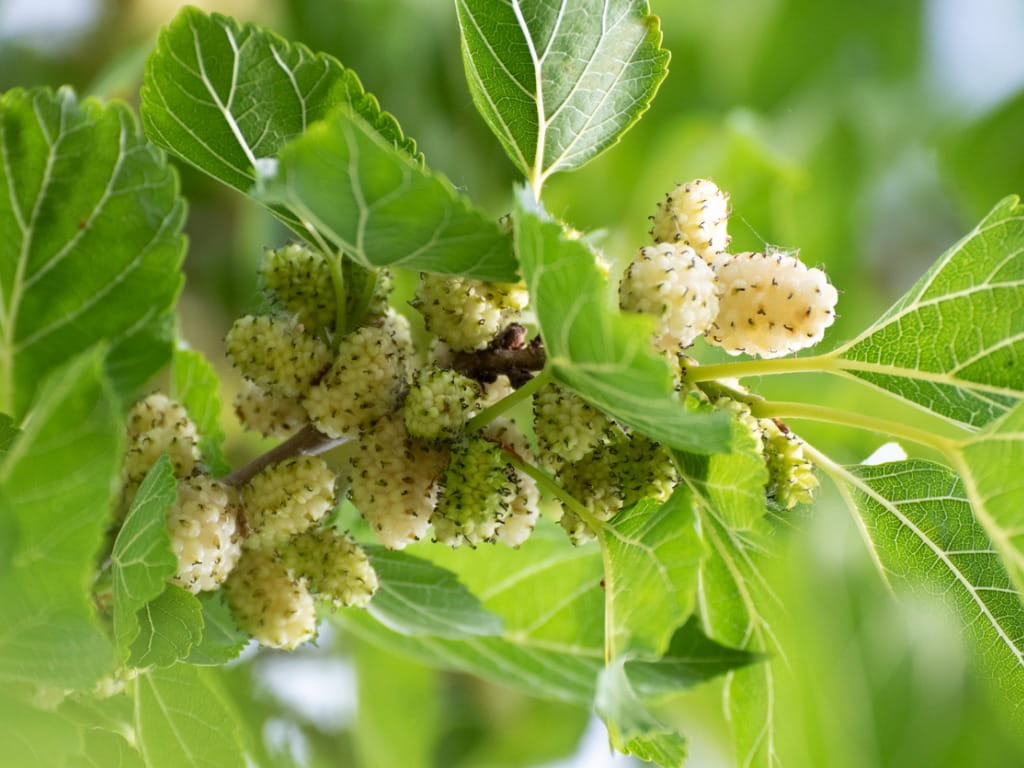Is White Mulberry Poisonous?

The Bottom Line
White mulberry is a leafy tree that grows across the US. The leaves contain considerable amounts of fiber and protein, and white mulberry leaf extracts are used as a dietary supplement for management of blood sugar, weight, and other conditions. White mulberry is generally associated with few adverse effects in humans.

What is white mulberry?
White mulberry (Morus alba L.) is a deciduous tree that originated in China, Japan, and India but is now found worldwide. White mulberry has been used as a traditional herbal remedy since at least 3000 BCE. The leaves of the plant contain multiple biologically active compounds, including antioxidants, amino acids, and alkaloids, which may have beneficial health effects. The leaves, fruit, and bark of the mulberry tree have historically been used to prevent and treat cancer, inflammation, diabetes, bacterial infections, and other conditions. The fruits of the white mulberry tree are often processed into jam, juice, and wine. The leaves of the white mulberry plant contain high concentrations of fiber and protein. In many countries, white mulberry leaves are used as a food source for both animals and humans. In Korea, powdered white mulberry leaves are used to make ice cream.
What do white mulberries look like?
Despite its name, white mulberry fruit is typically white, pale red, or deep purple in color when ripe. White mulberry fruit is often smaller than red mulberry fruit, and unripened berries of both species may be white in appearance. When ripe, both red and white mulberries are juicy and have a sweet taste.Where does white mulberry grow?
Currently, white mulberry trees grow worldwide and are found throughout the Americas, Europe, Africa, and Asia. The trees grow easily under various environmental conditions and are cheap to maintain. White mulberry tree bark is often orange/brown in color. The plant’s leaves can be oval or irregular in shape, and the fruits resemble blackberries.What is white mulberry used for?
White mulberry leaf extract is often used as a dietary supplement to improve blood sugar control, control obesity, and improve antioxidant activity within the human body. White mulberry extract has also been studied as a remedy for chemotherapy drug toxicity. In addition to their use in dietary supplements, white mulberry extracts are also found as ingredients in some cosmetic products.Can you eat white mulberry leaves?
White mulberry is generally considered to be edible and is associated with minimal toxicity in both humans and animals. In animal studies involving mice and rats, consumption of substantial amounts of white mulberry leaf extract did not result in adverse events or death.Does white mulberry cause weight loss?
White mulberry contains compounds that may reduce carbohydrate digestion, lower blood glucose levels, and improve lipid metabolism in the body. Because of these effects on digestion and metabolism, scientists have investigated the effects of white mulberry dietary supplements on weight loss. In one study, people with obesity who used white mulberry extract for 90 days had significantly more weight loss than those who took a placebo pill.What are the side effects of white mulberry use?
Since white mulberry reduces carbohydrate digestion, some people who take it may develop mild gastrointestinal distress, including nausea, abdominal bloating, and abdominal discomfort. Dietary supplements are not highly regulated by the FDA. Therefore, supplements that contain white mulberry may also have unwanted contaminants that can result in adverse or unexpected side effects.Is mulberry illegal?
White mulberry trees can withstand extreme temperatures, regenerate after being damaged in freezing weather, and tolerate various soil conditions. Because of this, white mulberry can grow in areas ranging from busy roadsides to forests. The tree’s aggressive roots can uproot sidewalks and disrupt home foundations. Given its invasive nature, the white mulberry is considered a nuisance species and is banned in certain areas of the country.What do I do if I get sick after eating white mulberry?
If you experience adverse or unexpected symptoms from white mulberry, or take too much, get guidance from Poison Control immediately. Help from Poison Control is available at webPOISONCONTROL and by phone at 1-800-222-1222. Both options are free, confidential, and available 24 hours a day.Kelly Johnson-Arbor, MD
Medical Toxicologist
Revised William G. Troutman, PharmD
Professor of Pharmacy Emeritus
Poison Control Media Information
Did you find this page helpful? If so, we need your support. Poison Control is in constant competition with misinformation online. Links to www.poison.org or our webPOISONCONTROL triage tool from other websites and blogs help internet searchers quickly find accurate information and Poison Control’s contact information in an emergency. If you use the content from this page, please provide attribution via a link back to this page, www.poison.org, or https://triage.webpoisoncontrol.org/#!/exclusions. By doing so, you could save a life. Thank you!
Poisoned?
Call 1-800-222-1222 or
Prevention Tips
- Use only USP-verified dietary supplements and herbal products.
- Tell your doctor about all dietary supplements and non-prescription medications that you are taking.
- Speak to your doctor or pharmacist before starting new medications or dietary supplements to ensure there are no drug interactions present.
This Really Happened
Thirty-eight healthy adult volunteers consumed a single dose of white mulberry extract or placebo in a study that investigated the effect of white mulberry leaf extract on blood sugar levels. The white mulberry extract was very well tolerated by all study participants, and no adverse events were reported during the study period.For More Information
White mulberry. Woody Invasives of the Great Lakes Collaborative. Accessed March 20, 2024.
White Mulberry. Missouri Department of Conservation. Accessed March 20, 2024.
References
Restricted tress for pollen control. City of Albuquerque. Accessed March 20, 2024.
Da Villa G, Ianiro G, Mangiola F, et al. White mulberry supplementation as adjuvant treatment of obesity. J Biol Regul Homeost Agents. 2014;28(1):141-145.
Gryn-Rynko A, Bazylak G, Olszewska-Slonina D. New potential phytotherapeutics obtained from white mulberry (Morus alba L.) leaves. Biomed Pharmacother. 2016;84:628-636.
Jan B, Parveen R, Zahiruddin S, Khan MU, Mohapatra S, Ahmad S. Nutritional constituents of mulberry and their potential applications in food and pharmaceuticals: A review. Saudi J Biol Sci. 2021;28(7):3909-3921.
Lee D, Yu JS, Lee SR, et al. Beneficial effects of bioactive compounds in mulberry fruits against cisplatin-induced nephrotoxicity. Int J Mol Sci. 2018;19(4):1117.
Li Y, Zhang X, Liang C, Hu J, Yu Z. Safety evaluation of mulberry leaf extract: Acute, subacute toxicity and genotoxicity studies. Regul Toxicol Pharmacol. 2018;95:220-226.
Suriyaprom S, Kaewkod T, Promputtha I, Desvaux M, Tragoolpua Y. Evaluation of antioxidant and antibacterial activities of white mulberry (Morus alba L.) fruit extracts. Plants (Basel). 2021;10(12):2736.
Thondre PS, Lightowler H, Ahlstrom L, Gallagher A. Mulberry leaf extract improves glycaemic response and insulaemic response to sucrose in healthy subjects: results of a randomized, double blind, placebo-controlled study. Nutr Metab (Lond). 2021;18(1):41.
Poisoned?
Call 1-800-222-1222 or
Prevention Tips
- Use only USP-verified dietary supplements and herbal products.
- Tell your doctor about all dietary supplements and non-prescription medications that you are taking.
- Speak to your doctor or pharmacist before starting new medications or dietary supplements to ensure there are no drug interactions present.
